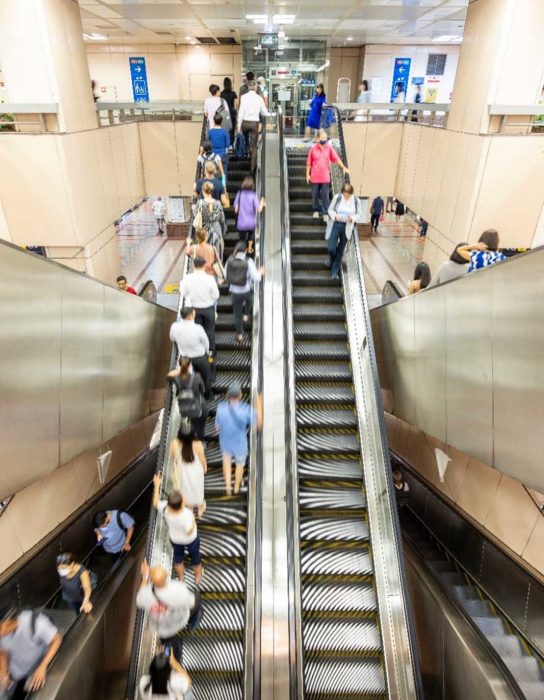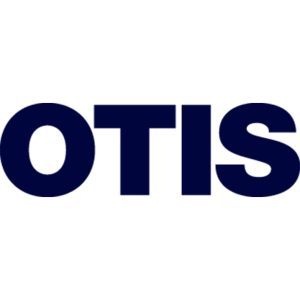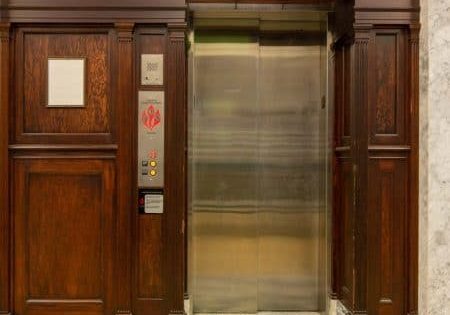Singapore Mass Rapid Transit
Jan 1, 2024
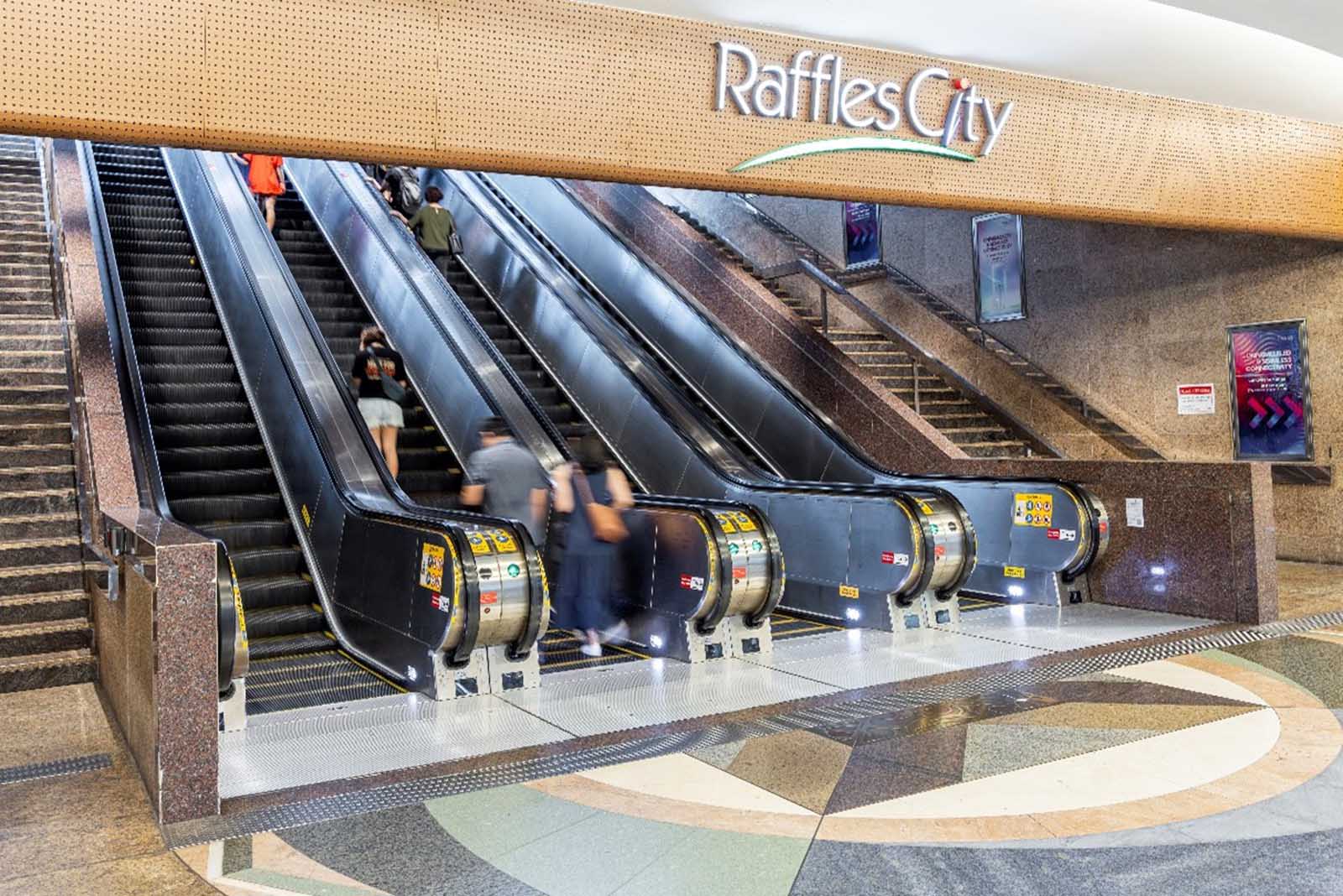
Escalators, Modernization
Singapore
submitted by Otis Elevator Co.
The Mass Rapid Transit (MRT) of Singapore derived from a forecast by the country’s planners in 1967 indicating a need for a rail-based urban transport system by 1992. The first section of Singapore’s North-South Line MRT, consisting of five stations over 6 km, opened in November 1987 as a priority since it passed through the Central Area, which had a high demand for public transport. Within a year, 20 more stations were added to the rail network, linking Central Singapore to Jurong in the West. The East-West Line was subsequently added, and the initial system was completed two years ahead of schedule in July 1990.
Since then, the system has expanded rapidly. Today, the MRT network is comprised of more than 140 stations serving approximately 3.4 million passengers daily, with an annual ridership of approximately 1.2 billion. There are nearly 600 trains, traveling at speeds between 78-90 kph (48-56 mph) along its 231-km (144-mi.), grade-separated route. The rail lines operate daily from 5:30 a.m. to 1 a.m., with the exception of selected periods during holidays and other special days.
Given a commitment to continuously maintain and modernize the rail system, Otis Elevator Co. was selected by rail operator SMRT Trains to refurbish and modernize its 231 OEM escalators that had been installed 30 years prior to serve 42 SMRT stations on the North-South and East-West Line (NSEWL). The six-year project was completed in July 2022.
Transportation System Description
Singapore’s NSEWL is the oldest and busiest metro system in Southeast Asia, with a network of stations along its route. So, it comes as no surprise that SMRT Trains and the Land Transport Authority (LTA) turned to Otis to upgrade, refurbish and modernize its 231 escalators. It was the first major refurbishment project since the NSEWL began operation in 1987 and was particularly important given these are the most heavily utilized rail lines in the SMRT network.
Otis was the logical choice given it had the escalators’ original design parameters, ensuring they would be modernized to meet the latest code requirements and would feature green technologies and improved reliability. The aim of the project was to ensure the 30-year-old escalators would continue to provide best-in-class service for up to 20 h a day at a 99.9% availability level, to an ever-increasing traveling public for decades to come. Dr. Tan Chee Keong, vice president, Building and Facilities, SMRT Trains, said:
“As the train stations were in operation throughout the refurbishment project and most of the work was done during the day, the safety and convenience of our commuters were of utmost importance to us. In addition, we aimed to enhance the escalators by integrating advanced technology and incorporating additional safety features.”
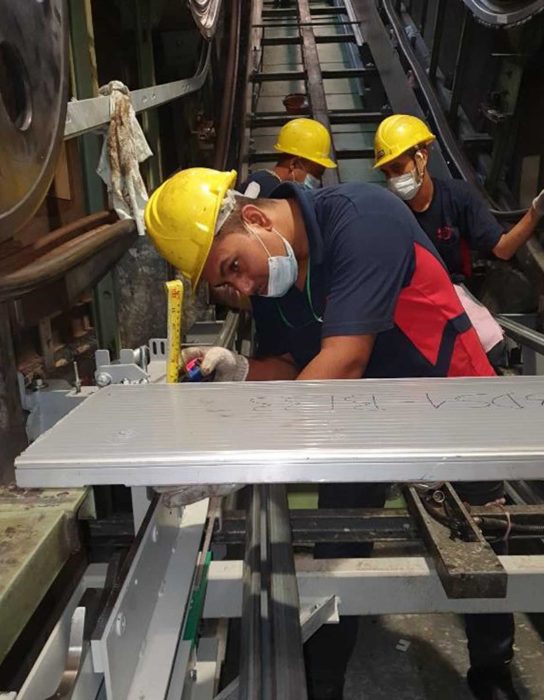
To achieve these goals, SMRT Trains requested that Otis develop three options for evaluation based on environmental factors (noise and structural implications), downtime disruption to commuting passengers and cost effectiveness. Otis looked at a total change-out of the escalators, including the units’ structural trusses; a total change-out without replacing the trusses; and refurbishment. It eventually decided to modernize and refurbish the existing escalators, without change-out, through a customized solution in which all static parts, including trusses and balustrades, would be retained, while components subject to fatigue or wear would be replaced.
As part of the upgrade, LTA and SMRT also requested the introduction of dual speeds to the escalators along the North-South and East-West lines. The upgraded escalators now move at different speeds to better cater to passenger traffic during different periods of the day, making them more energy- and cost-efficient. During peak travel hours, the escalators move at a rated speed of 0.75 m/s (50% faster than conventional escalators) to transport more passengers as trains arrive and depart from the stations. They are programmed to move at a slower speed of 0.5 m/s during off-peak hours. The escalators slow to 0.20 m/s when no passengers are present. Overall, the speed variations make travel safer for the elderly, as well as young children.
Each escalator was upgraded with additional safety features, higher efficiency machines and new energy-saving controllers. The new controllers use Otis’ microprocessors, coupled with the Multifunction Escalator Safety Device (MESD) to deliver an even safer escalator. The new system features include a radar sensor as a means of passenger detection and an energy-saving device, allowing the escalator’s speed to be slowed dramatically when not in use. In addition, it includes a Fault Diagnostic System so that faults can be identified easily, allowing for more accurate troubleshooting and reducing the number of breakdowns, thus reducing commuter inconvenience. It also features an upgraded system that can record individual faults, as well as the ability to change controller parameters easily to facilitate testing and troubleshooting. A new control panel, which acts as a fault indicator installed in the escalator decking, allows station managers to easily identify faults and decide the next course of action without the need to access the escalator controller.
The new controller also is capable of storing up to 8,000 events, complete with time of occurrence which can be downloaded to a laptop; a serial link communication function; a key switch to manually trigger the auxiliary brake, allowing the escalator to be used as a stairway; and a maintenance mode, which prevents events from being sent to the Passenger Control Center when the team is carrying out regular maintenance.
Among other components replaced were the main drive shaft assembly, tension carriage assembly, tracks system, handrail drives and floor, middle and comb plates. A new automatic lubrication system, SMART LUBRICATION, was also added. And all of the escalator’s stainless steel was polished and glass surfaces cleaned.
Given Otis’ and SMRT’s top priority commitment to public safety, as well as compliance with the latest Code safety requirements, all safety devices and field wirings were replaced, the braking mechanism was upgraded and the brake shoes replaced. Existing worm gear machines were replaced with hypoid helical gear machines, which have higher torque, are more efficient and are designed for heavy traffic applications.
Other newly introduced safety features include lighted arrows to indicate the direction each escalator is moving and skirt deflectors — barriers between the escalator steps and the skirt panels — that can prevent passenger’s feet or clothing from getting caught between the gaps. In addition, handrail speed monitors activate a stop command when a handrail loses its tension or when the handrail speed deviates from the step speed.
Upon awarding of the contract, Otis, together with the SMRT Trains and Corporate Communications teams, began designing the hoarding (temporary barriers set up between the escalator work site and public space) to enclose the escalators during the modernization and inform passengers what to expect and how long the escalator would be out of service. Furthermore, SMRT’s Corporate Communications team also produced a series of videos with some of Singapore’s famous local artists to educate commuters on the need for escalator refurbishment.
The overall intent was to allow work to be carried out within the hoardings without disturbing the traffic flow of passengers. Another benefit came in providing public information about the ongoing work. Details on the panels — in words and graphics — faced the public and described the work that was ongoing and in what order, as well as a timeline of events and contact information, including a hotline and email address. One panel titled: “We’re Working on It” asked the question, “What happens during an escalator refurbishment?” with No. 1 being, Removal of existing parts; two, Cleaning and inspection; three, Installation of new parts; four, Installation of safety devices; five, Testing & commissioning; and six, Refurbishment completed.
The hoardings were critical to safety, as most work was done during the day, except for equipment delivery, which occurred after operating hours to mitigate any disruption to passenger traffic in the full and operational stations.
Otis had to make some adjustments to its work processes and overcome some challenges during the project. Typically, a team of two Otis mechanics would work on a single escalator unit to completion before moving on to the next one. To minimize inconvenience to passengers, only one escalator at a time was shut down in each station throughout the project, except for two larger stations. In these two stations, Otis was allowed to shut down two escalators at a time, but they had to be at two different locations to minimize the impact on passenger traffic flow. This ensured public safety was always the number one priority throughout the project.
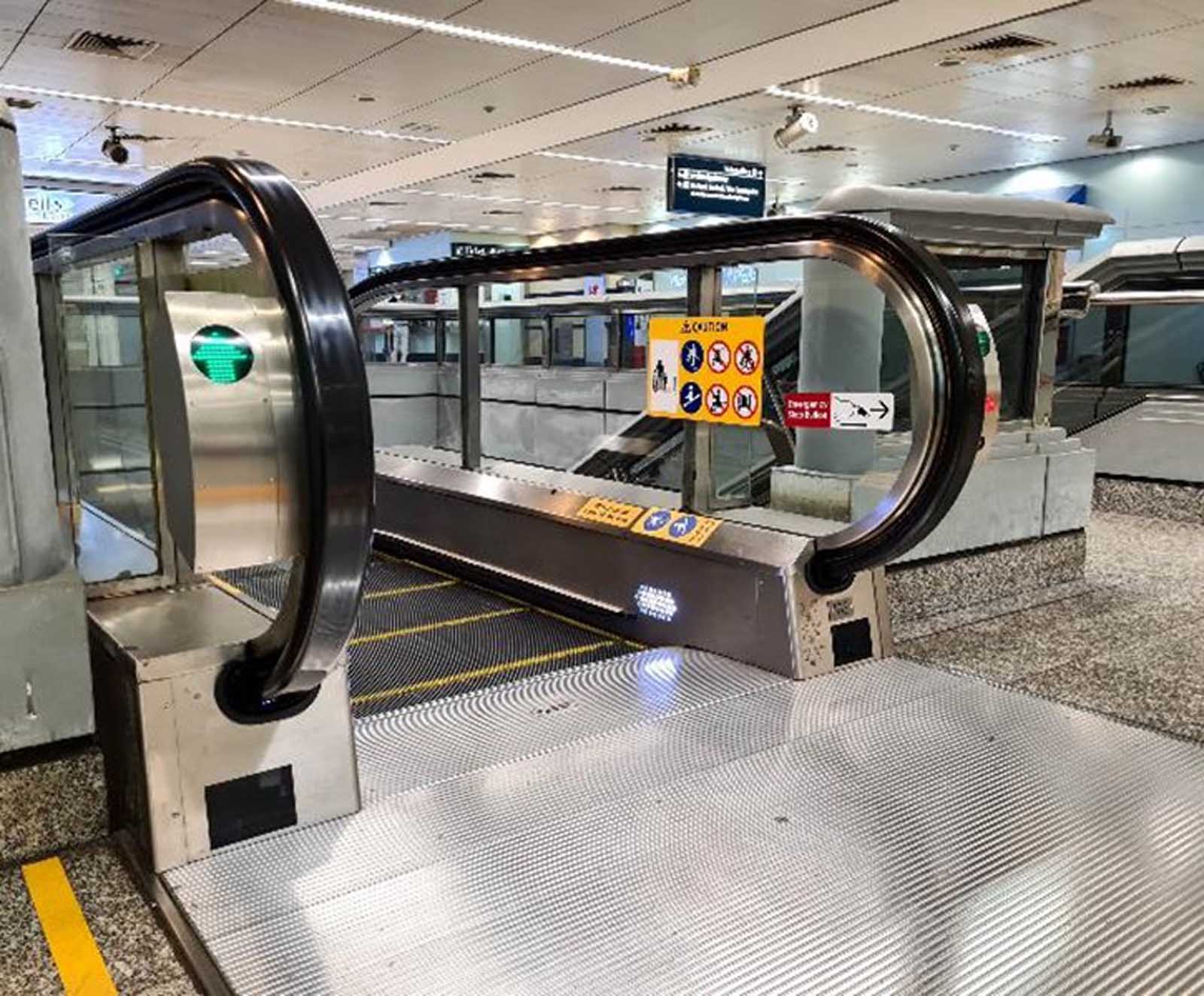
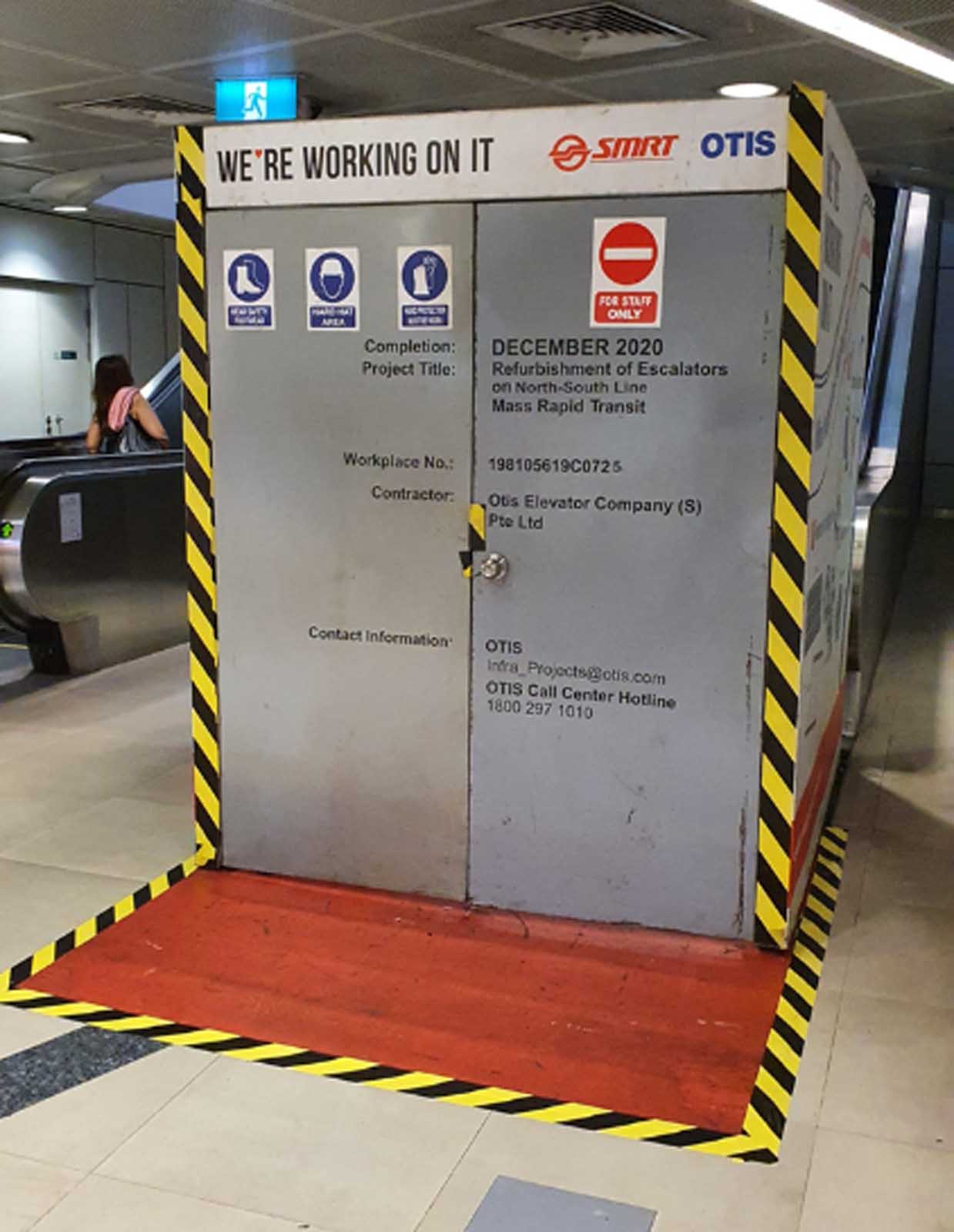
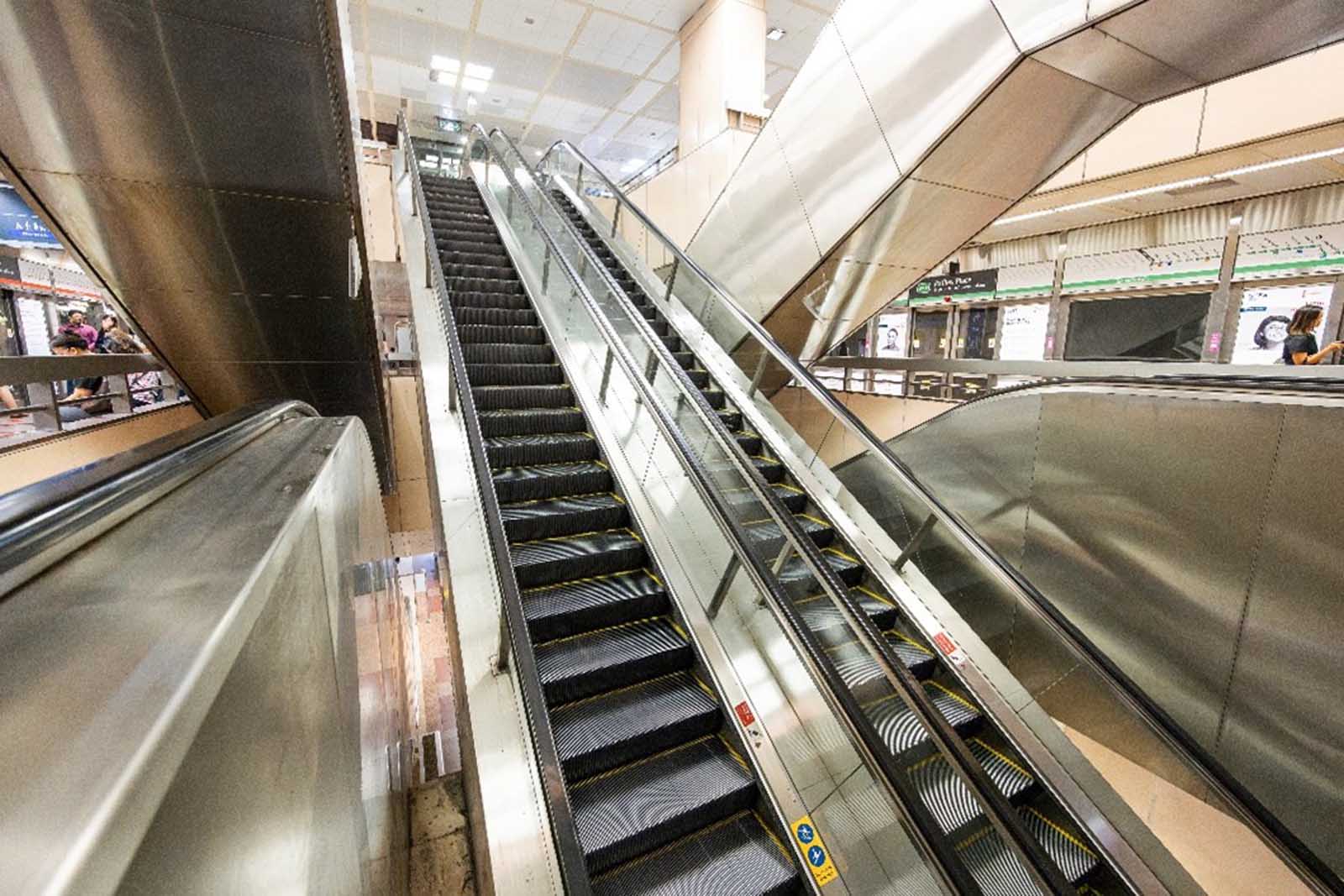
Just-in-time deliveries of parts were established to ensure the right parts were in the right place at the right time. In each station, a small staging area was built to allow new and dismantled components to be staged, and components were delivered or removed from the site in batches to minimize the staging area required. All parts for a certain escalator arrived from the factory in a kit to ensure parts and other material weren’t mixed.
Another challenge faced was the discovery of water seepage from the structure, causing corrosion to the escalator truss. Apart from coordinating with SMRT Trains’ Structure Maintenance team to rectify the water seepage, Otis engaged a professional engineer to study the rectification works to the corroded steel escalator truss to ensure its safe use over the next 30 years.
In addition to the refurbishment or replacement of components, various technologies — including eddy-current inspection and ultrasonic examination — were used to ensure the integrity of the truss and enable it to last for the next 30 years.
In the end, this coordination of efforts by Otis and SMRT Trains came together, resulting in a safe, efficient and successful modernization. Otis installed the escalators 30 years ago and proudly modernized them to confirm that they will last for the next 30 years. From planning, options evaluation, understanding site constraints and customizing the modernization solution, the company worked closely with the customer to deliver a result that meets the continuing — and growing — needs of the traveling public and ensures the safety of every passenger that rides these Otis escalators.
Credits
Customer: SMRT Trains
Developer: Land Transport Authority
Construction Manager: SMRT’s Project team
Transportation-Systems Contractor: Otis Elevator Co.
Equipment Manufacturer: Otis Elevator Co.
Consultant: Land Transport Authority
Get more of Elevator World. Sign up for our free e-newsletter.
